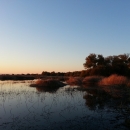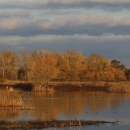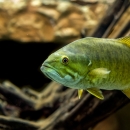States
MichiganOverview | Trustees | Assessment | Settlement | Restoration Plan and Projects | Additional Site Information | Administrative Record Index
Overview
Beginning as early as the late 1800s, the Dow Chemical Company plant in Midland, Michigan, released pollution into the Tittabawassee River. In time, the river and its floodplain were contaminated by polychlorinated dibenzo-p-dioxins and polychlorinated dibenzofurans, commonly referred to collectively as dioxins. Dow did not purposely produce dioxins; rather they were inadvertent by-products of chemical production processes.
Because dioxins have injured natural resources downstream from Dow’s Midland plant and resulted in fish consumption and other advisories, federal, state, and tribal governments acting on behalf of the public as Trustees for natural resources have conducted a Natural Resource Damage Assessment (NRDA).
The purpose of an NRDA is to determine the amounts and types of restoration that can make the public whole for losses to natural resources over time. The Trustees began planning for and conducting their assessment in 2005 and reached a settlement with Dow in 2019. The settlement includes a suite of restoration projects to benefit natural resources and provide for public use and enjoyment of them and funding for the Trustees to do additional restoration and monitoring over time.
In their Restoration Plan, the Trustees evaluated a range of restoration actions and alternatives which would provide benefits to natural resources to compensate the public for losses to natural resources injured by releases from Dow's Midland plant. They described both the assessment and the proposed restoration actions in the Draft Restoration Plan and Environmental Assessment for the Tittabawassee River System and released it on November 8, 2019, for public review and comment through December 30, 2019. Based on the comments received, the Trustees published the Final Restoration Plan and Environmental Assessment for the Tittabawassee River System on March 10, 2020. For more information on the restoration projects selected, please visit the Restoration Plan and Projects section.
Trustees
Trustees for natural resources for this site are the State of Michigan, acting through the Director of the Michigan Department of Environment, Great Lakes, and Energy, the Director of the Michigan Department of Natural Resources, and the Attorney General of the State of Michigan; the United States Department of the Interior, acting through its representatives, the U.S. Fish and Wildlife Service and the Bureau of Indian Affairs; and the Saginaw Chippewa Indian Tribe of Michigan.
Assessment
Below are Trustee reports for the Tittabawassee River, Michigan, Natural Resource Damage Assessment. Reports with an asterisk (*) can be requested by contacting Kaylyn Flanigan.
Available Reports
- Update on the Tittabawassee NRDA, presentation made to Citizen's Advisory Group (May 16, 2016)*
- Tittabawassee River System Restoration Workshop (January 27, 2009)*
- Natural Resource Damage Assessment Plan for the Tittabawassee River System Assessment Area - Public Release Draft (April 2008)*
- Presentation on NRDA Assessment Plan (April 17, 2008)*
- Presentation on Restoration Criteria NRDA (November 28, 2007)*
- Preassessment Screen and Determination, signed by co-trustees (2006)*
- Presentation on NRDA (November 2005)*
Settlement
On July 20, 2020, the settlement with the Dow Chemical Co. to address federal, state, and tribal claims for natural resource damages was finalized in a Consent Decree. The settlement is for an estimated $77 million in projects and funding that will restore fish, wildlife, and habitats injured following releases of hazardous substances in past decades from Dow’s manufacturing facility in Midland, Michigan. This settlement was reached following many years of assessment and negotiations. This settlement was first announced on November 8, 2019, when it was lodged with the federal court and provided to the public for review and comment.
The settlement addresses natural resource injuries with restoration projects within Midland, Saginaw, Bay, and nearby counties. The ongoing clean-up efforts in the Tittabawassee and Saginaw Rivers continue as part of a separate process. This settlement does not affect that clean-up process, and the restoration work is now progressing as the ongoing clean-up efforts continue.
The Trustees and Dow are implementing restoration projects according to the Consent Decree for the settlement and the Trustees' 2020 Restoration Plan.
Projects and Funding
Under the settlement, Dow is implementing a number of restoration projects identified in Midland, Bay, Saginaw, and nearby counties and has provided funds to the Trustees to implement additional projects. These projects include fish spawning and fish passage fish passage
Fish passage is the ability of fish or other aquatic species to move freely throughout their life to find food, reproduce, and complete their natural migration cycles. Millions of barriers to fish passage across the country are fragmenting habitat and leading to species declines. The U.S. Fish and Wildlife Service's National Fish Passage Program is working to reconnect watersheds to benefit both wildlife and people.
Learn more about fish passage improvements; restoration of thousands of acres of wetlands and other habitats; creation of multiple public nature areas with nature trails, fishing platforms, and a bike trail segment; protection of a green corridor along the Tittabawassee River; and expansion of boating access at the mouth of the Saginaw River.
The settlement also provided approximately $10 million for long-term stewardship of the restoration projects, monitoring, and trustee costs to implement the settlement.
In addition to the NRDA-specific settlement, the State simultaneously resolved certain claims with Dow that resulted in both the funding and the property to support two additional projects to benefit the community. These projects include a docking facility and education center on the Saginaw River in or near Bay City to bolster BaySail’s environmental science program and the renovation of the Saginaw River Rear Range Lighthouse to allow for public use.
Amount | Description |
|---|---|
| $15 Million | Dow to pay Trustees for new projects, long term care of projects, monitoring, staff time |
| $6.75 Million | Dow to pay Trustees for 5 specific projects |
| ~$50 Million | Estimate of what it would cost the Trustees to do the 8 projects that Dow will do |
| ~$5 Million | Dow to pay Trustees for assessment costs |
| ~$77 Million | Total estimate for settlement amount used in press release |
Public Comments
The public was encouraged to provide comments on the Draft Restoration Plan and Environmental Assessment as well as on the proposed Consent Decree that outlined the settlement provisions.
On November 14, 2019, the Department of Justice published a Federal Register Notice advising the public of the opportunity to submit comments on both documents through December 30, 2019.
Restoration Plan and Projects
Restoration Plan
In their 2020 Restoration Plan, the Trustees evaluated a range of restoration actions and alternatives which would provide benefits to natural resources to compensate the public for losses to natural resources injured by releases from Dow's Midland plant. The Trustees released the Draft Restoration Plan and Environmental Assessment for the Tittabawassee River System on November 8, 2019, for public review and comment through December 30, 2019. Based on the comments received, the Trustees published the Final Restoration Plan and Environmental Assessment for the Tittabawassee River System on March 10, 2020.
Restoration Projects that Dow is Implementing or Trustees Are Implementing with Funds from Dow
Project name | Description |
|---|---|
| Midland Fish Passage | The Dow Dam on the Tittabawassee River in Midland currently impedes fish passage during most flow conditions. The Midland Fish Passage Project will provide a fish passage structure that improves the ability for fish to swim upstream and downstream while maintaining water elevations upstream. The Project will provide fish access to important upstream aquatic habitats and expand recreational fishing opportunities. |
| Eagle Ridge Nature Area | Preserves and enhances 140 acres of forest and marsh habitat in Midland, providing a unique urban nature preserve adjacent to the existing Stratford Woods Park. |
| Greater Midland Nature Preserve | Preserves and enhances 1,460 acres of existing farmland and woodlands across three tracts southeast of Midland. The approximately 940 acres of farmland currently present will be restored to natural habitat, including wetlands. Provides public access trails and conservation education in prairie, wetland and forest habitats. |
| Tittabawassee River Floodplain Restoration and Bike Trail | Preserves 490 acres of floodplain habitat along the Tittabawassee River south of Midland. The existing 175 acres of farmland on the site will be restored to natural habitat. Develops approximately 2 miles of bike trail and additional nature trails within the floodplain, along the Tittabawassee River, with the goal of connecting to the Great Lakes Bay Regional Trail, a larger bike trail system in the area. |
| Thomas Township Nature Preserve | Provides partial funding to restore 60 acres of farmland which will be open to the public as a nature preserve with outdoor recreation, including river access for kayaking, canoeing and fishing. |
| Tittabawassee River Green Corridor | Protects 2,000 acres of private land in the Tittabawassee River floodplain, between Midland and Saginaw, from future development through conservation easements (as of October of 2019, over 1,800 acres already recorded). |
| Saginaw Riverfront Park | Provides funding to help create and maintain the 332 acres of Saginaw Riverfront Park in urban Saginaw. |
| Shiawassee National Wildlife Refuge Restoration Projects | Provides funding for restoration enhancements expected to affect 2,708 acres. |
| Shiawassee National Wildlife Refuge Expansion | Land for hunting will be acquired, preserved, and made available to the public using $1.2 million in dedicated funds. This is in addition to preserving approximately 150 acres along the Tittabawassee River in Saginaw that was already purchased with funding provided by Dow and is being managed by the Shiawassee National Wildlife Refuge. |
| Saginaw River Mouth Boating Access Site Expansion | Expands parking capabilities by 50 spaces and increases the boat launch lanes from 5 to 8 to improve capacity and efficiencies at this popular Michigan Department of Natural Resources access site. |
| Bay City Ecological Restoration | Preserves and restores wetlands, lake plain prairie and other habitat types on 415 acres near the mouth of the Saginaw River, including phragmites management and incorporating nature trails and shoreline fishing opportunities. |
| Saginaw Bay Spawning Reef Project | Provides funds to allow the Michigan Department of Natural Resources and its partners to construct a rock reef, or reefs, in Saginaw Bay to provide fish habitat and spawning areas. |
| Saginaw Chippewa Indian Tribe Restoration | Provides funding to preserve and restore approximately 80 acres of habitat near Standish by the Saginaw Chippewa Indian Tribe of Michigan. |
Project Name | Description |
|---|---|
| BaySail | Provides land and partial funding for a docking facility and education center for BaySail, near the Saginaw River Rear Range Lighthouse and adjacent to the Bay City Ecological Restoration Project. |
| Saginaw River Rear Range Lighthouse | Provides funding for lighthouse renovation and preservation, adjacent to the Bay City Ecological Restoration Project. |
Additional Restoration Projects to be Funded from the Settlement
In November of 2021, the Tittabawassee River Natural Resource Trustee Council, together with the Saginaw River and Bay Trustee Council, solicited pre-proposals for additional restoration projects to be implemented in the Saginaw Bay watershed, including in and along the Tittabawassee and Saginaw rivers. The two Trustee Councils combined funding to provide a total of up to $5.75 million to fund these additional restoration projects, in addition to projects already described in the restoration plans for the two settlements. Restoration pre-proposals were accepted until December 31, 2021.
The Trustee Councils developed a Draft Supplemental Restoration Plan and Environmental Assessment (Draft Plan), that described the stakeholder projects that best met the Trustees’ restoration criteria and were proposed for funding. The Trustees’ restoration criteria and evaluation process were also described in the Draft Plan.
In the Draft Plan, the Trustees described how they evaluated 16 projects that met their eligibility criteria for consideration. In some cases, pre-proposals for projects were further developed with project proponents and several projects were combined with others.
After reviewing the public comments received, the Trustees selected ten projects. Two projects consist primarily of acquisition (fee title and easements); seven projects incorporate elements of riparian riparian
Definition of riparian habitat or riparian areas.
Learn more about riparian or wetland restoration and natural resource-based recreation; and one project will contribute to conservation of a state-listed species, the lake sturgeon. The Trustees describe these projects in their Tittabawassee River – Saginaw River & Bay Natural Resource Trustee Councils Final Supplemental Restoration Plan and Environmental Assessment (Supplemental Restoration Plan), published July 7, 2023. The Trustees are working with partners to implement these projects.
Additional Site Information
The following websites provide additional information about the Site:
- U.S. EPA Tittabawassee River, Saginaw River & Bay Superfund Site
- Michigan Department of Environment, Great Lakes, and Energy - Midland Area Soils Corrective Action
- Michigan Department of Health and Human Services - Dioxins, Furans, and Human Health includes advisories for fish, wild game and floodplain soils.
Administrative Record Index
Tittabawassee River Natural Resource Damage Assessment and Restoration Administrative Record Index







